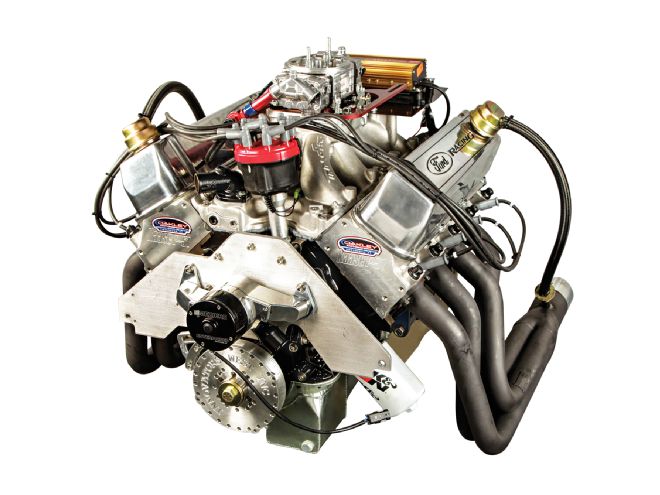
When it comes to big-block V8s, Chevy’s venerable Rat motor has received the lion’s share of attention over the years from hot rodders seeking plus-sized horsepower and torque, but the aftermarket has provided another big-block some attention: the Ford big-block, which hasn’t been given the spotlight it truly deserves.
Known as the 385-series big-block, these engines were built at Ford’s Lima Engine Plant in Lima, Ohio. They debuted in 1968 as 429ci mills and were mostly known for powering fullsize family cars like the Lincoln Continental and Ford Thunderbird. The 1970s emissions restrictions caused the 385-series engines’ horsepower ratings to fall down to the low-200hp range shortly after its introduction. The 429ci and 460ci engines were phased out of passenger cars in the mid 1970s and relegated to trucks and RVs through the 1980s before finally going out of production in 1997.
Most of the 385-series engine’s legacy, especially the 460, was in low-horsepower and fairly unexciting vehicles. Thankfully, that’s no longer the case. This particular 572ci beast walked away with both the Horsepower King and the Torque Monster awards at the 2013 AMSOIL Engine Masters Challenge (EMC) with peaks of 870 hp at 6,400 rpm and 816 lb-ft of torque at 4,800 rpm, so the Ford big-block obviously has massive potential.
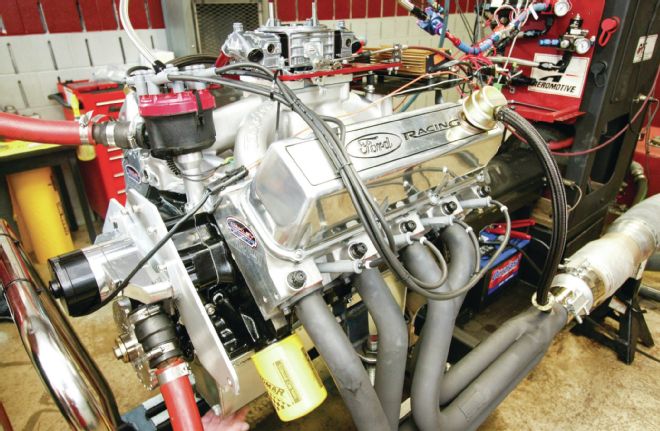
Built as a joint venture between Freelander Race Engines and Oakley Motorsports, this behemoth really isn’t “anything all that special,” according to the team. It was pieced together mostly from parts the two builders had sitting around. Despite the expected power levels, Freelander and Oakley knew from the beginning they were concocting an engine too big to win the Engine Masters Challenge, which rewards power per cubic inch; they showed up with the intent to take the top power prizes. “The whole idea was to build a big-ass engine,” Freelander told us. “I saw Eric Weingartner [of Weingartner Racing] at EMC and knew he built a big Chevy. I said, ‘Hey, whatcha build, buddy?’ He said, ‘Brought a 540ci Chevy, gonna take Horsepower King and Torque Monster.’ I told him I brought a 572ci Ford, and his jaw hit the ground,” Freelander said with a laugh.
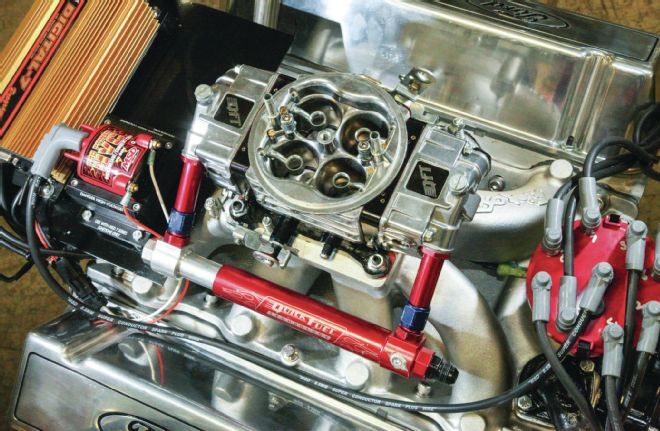 Based on QFT’s 1,050-cfm Race Q carb, this one is basically a refined version. Freelander and Oakley traded carbs back and forth with QFT to help dial in the right combination. The ignition curve is handled by an MSD Performance Digital 7 with a Pro Power HVC coil, Pro Billet distributor, and Super Conductor wires.
Based on QFT’s 1,050-cfm Race Q carb, this one is basically a refined version. Freelander and Oakley traded carbs back and forth with QFT to help dial in the right combination. The ignition curve is handled by an MSD Performance Digital 7 with a Pro Power HVC coil, Pro Billet distributor, and Super Conductor wires.
The sheer size of the 385-series block’s skirtless crankcase allows copious amounts of stroke in the rotating assembly without the need to grind the block for clearance. Combined with a 4.900-inch bore spacing, thick cylinder walls, a 10.320-inch deck height, and a camshaft positioned high in the block, these engines just scream that more size was in the plans for this engine family. Stock 460s used a relatively short 3.850-inch stroke, but the generous real estate effortlessly swallows up much longer-armed cranks; a 4.300-inch crank will drop right in with zero grinding for rod clearance, and a 4.500-inch crank requires only a very slight notch at the bottom of each cylinder. A 429 or 460 Ford can be built as large as 559 ci with production blocks and off-the-shelf components.
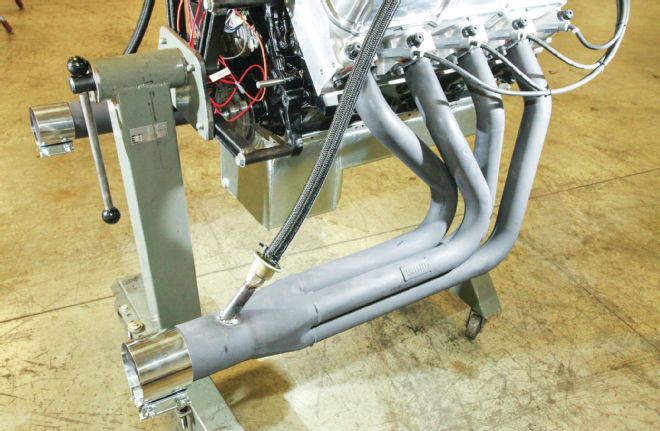 The Schoenfeld headers are good, but Freelander feels a lot of power was left on the table for the dyno pull. He said in his experience, the more header the better on these big Fords.
The Schoenfeld headers are good, but Freelander feels a lot of power was left on the table for the dyno pull. He said in his experience, the more header the better on these big Fords.
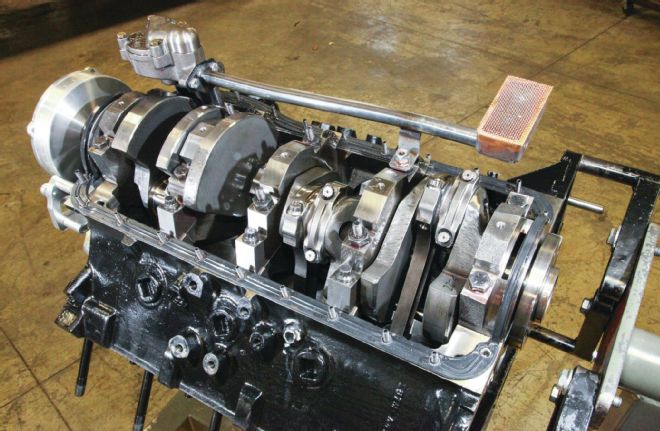 Cooling was controlled by a Meziere electric pump, while an Innovators West dampener handled harmonics. Freelander had this dampener made with the crank trigger magnets built in.
Cooling was controlled by a Meziere electric pump, while an Innovators West dampener handled harmonics. Freelander had this dampener made with the crank trigger magnets built in.
Ford Racing’s A460 block was developed for huge cubic inches and big power numbers. It uses the same 10.320-inch deck height as a stock 460 engine block, but its cylinder bores are siamesed for increased cylinder strength and stability. The bore range is from 4.360–4.600 inches, allowing up to 598 ci. Plus, rather than 10 head bolts per head, the A460 has 18.
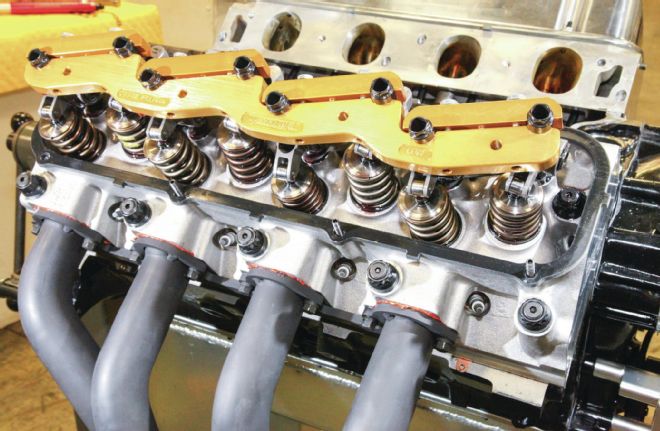 Freelander uses Jomar Performance Products rocker girdles. He’s seen a solid 12hp difference in testing due to decreased rocker stud flex. “Any time you start getting over 150 pounds on the seat, you’re probably going to start seeing a difference,” Freelander said.
Freelander uses Jomar Performance Products rocker girdles. He’s seen a solid 12hp difference in testing due to decreased rocker stud flex. “Any time you start getting over 150 pounds on the seat, you’re probably going to start seeing a difference,” Freelander said.
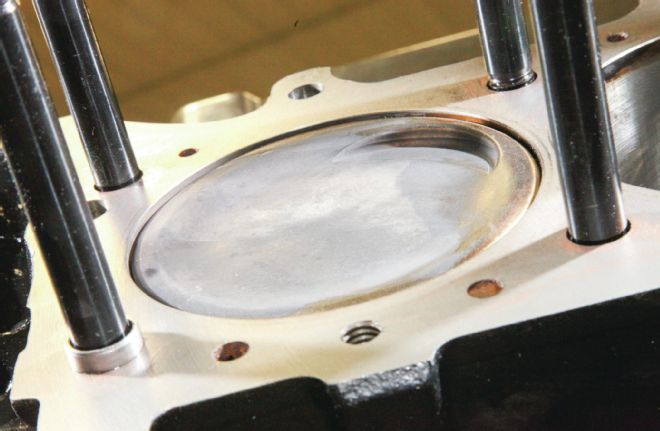 The 28cc dish Diamond Racing pistons sit in the big 4.600 bore at zero deck with a 1.350-inch compression height. “Not many guys build something this large while trying to keep a realistic street compression ratio,” Freelander said.
The 28cc dish Diamond Racing pistons sit in the big 4.600 bore at zero deck with a 1.350-inch compression height. “Not many guys build something this large while trying to keep a realistic street compression ratio,” Freelander said.
Below, the A460 block is similar to the production 460 block, but gets splayed four-bolt, nodular iron main caps. There’s also more material in the lifter valley and on the pan rails to keep everything stable at high power levels.
Maxing out those cubes used to require a very expensive crank, but fortunately, Scat has stepped up with a much more affordable option. Freelander opted for a 4.300-inch stroke and paired it with 6.800-inch Oliver rods. The pistons are custom parts from Diamond Racing with a 28cc dish to get the compression level down to 11.5:1.
Despite canted valves and huge ports derived from the 351 Cleveland program, there are no production 385-series heads truly worthy of the engine’s potential. Thankfully, that’s a travesty the aftermarket would not let stand. There are several great options out there, but Freelander is fond of Jon Kaase Racing’s P51 head. Developed as an evolution of the Super Cobra Jet head Kaase R&D’d in conjunction with Ford Racing, Kaase’s revision created a bolt-on head addressing all of the original design’s issues and flows more than 350 cfm. The P51 took everything a step further. Building upon the gains made in port development on the Super Cobra Jet head, the P51 was to be an “as-cast” head exhibiting the traits of a fully ported Super Cobra Jet. Flow out of the box is 400 cfm at 0.700 inch of lift, but Freelander and Oakley went even further with port work resulting in upward of 430 cfm at 0.700.
“There’s a certain stigma in the 460 Ford community regarding hydraulic roller cams,” Freelander explained. “The rumor is that Ford never offered it in production vehicles because the tall lifter created geometry issues causing reliability problems.” Because of that, you’ll mostly find flat-tappet cams or solid rollers in 460 builds, and plenty of banter on message boards about whether or not it’s a good idea to make the hydraulic swap. Freelander has proven it can work just fine. Using a Comp Cams billet hydraulic roller with 0.817/0.817 life and 266/272 duration at 0.050 paired with big 3⁄8-inch pushrods and Morel 0.904 lifters, the 572ci pulled cleanly to 7,200 rpm in all pretesting dyno runs and was just as issue-free at the EMC competition. Freelander says the big 0.904 Morel lifters were critical to the project’s success, enabling the acceleration rate he was looking for. He also opted for bronze lifter bushings since he planned to recycle the engine into his dragster, and bronze is so much more forgiving. “I don’t know how long I would trust them on the street,” Freelander said, “but the lifters looked brand new after 80 to 90 dyno pulls.”
The Trick Flow Mafia, that is. Actually, the correct name for this intake is the R-series, but in 460 circles it often goes by “Mafia.” Freelander is close with the guys who worked with Trick Flow to develop this intake and says it’s quite good right out of the box for a big engine. In fact, it’s so good they did nothing other than a touch of port matching before dropping on the carb. Working with Quick Fuel Technologies (QFT), Freelander and Oakley spec’d out a custom 1,050-cfm 4150 carb to sit atop an adaptor plate for the Trick Flow intake’s 4500 flange, but Freelander told us it’s really nothing crazy and QFT will happily build you a copy.
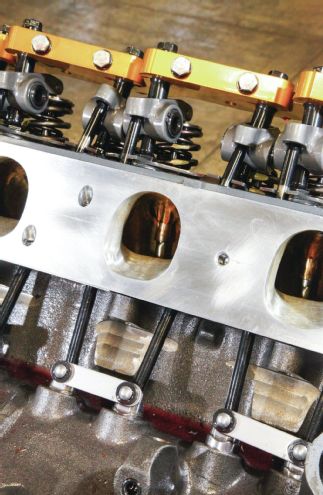 Here’s a glance at some of the porting work on the intake side of the P-51 heads.
Here’s a glance at some of the porting work on the intake side of the P-51 heads.
 The Morel hydraulic lifters are special 0.904-inch-diameter units. Though these lifters feature full plunger travel, they worked flawlessly with high spring loads and 7,000-rpm pulls.
The Morel hydraulic lifters are special 0.904-inch-diameter units. Though these lifters feature full plunger travel, they worked flawlessly with high spring loads and 7,000-rpm pulls.
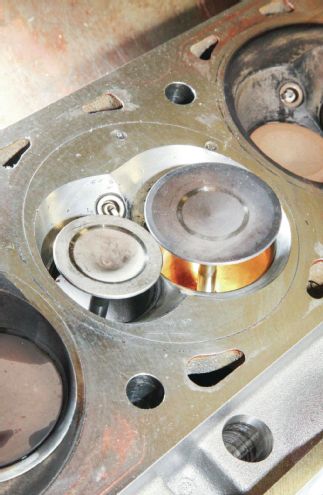 On the P-51 head, both valves are pulled back toward the intake side of the chamber and the valve angle was altered. The intake port measures 310 cc and uses 2.250-inch valves, while the exhaust ports measure 145 cc and carry 1.76-inch diameter valves. The port throats below the valves come machined and hand-blended.
On the P-51 head, both valves are pulled back toward the intake side of the chamber and the valve angle was altered. The intake port measures 310 cc and uses 2.250-inch valves, while the exhaust ports measure 145 cc and carry 1.76-inch diameter valves. The port throats below the valves come machined and hand-blended.
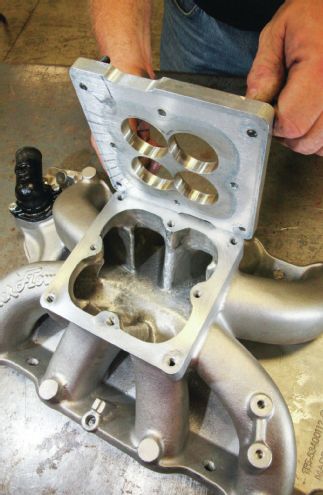 Milled from ½-inch aluminum, the 4150–4500 adapter plate allowed Freelander and Oakley to run the intake they wanted while still meeting the EMC rules requiring a 4150-style carb.
Milled from ½-inch aluminum, the 4150–4500 adapter plate allowed Freelander and Oakley to run the intake they wanted while still meeting the EMC rules requiring a 4150-style carb.
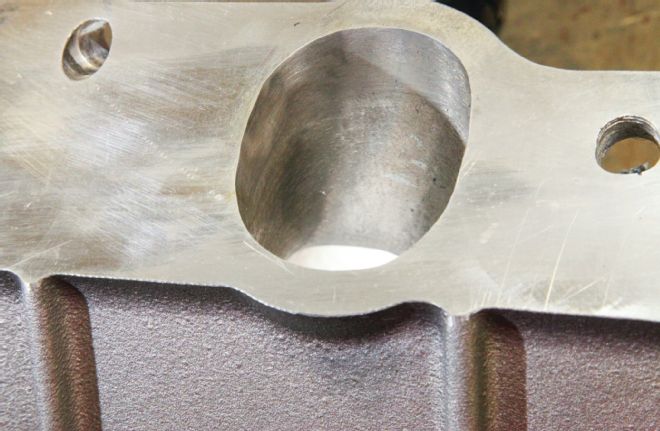 Here’s a closer look inside that Trick Flow intake. Freelander swears they did almost nothing to it other than light clean up and port matching.
Here’s a closer look inside that Trick Flow intake. Freelander swears they did almost nothing to it other than light clean up and port matching.
572ci Ford 385 Series Team leader and members David Freelander, Phillip Oakley, Mike Miller, Jay Aokley, and Rob Orava Engine type Ford 385 Series Claimed displacement 572 ci Block Ford Racing A460 Bore x stroke 4.600 x 4.300 in Compression ratio 11.5:1 Compression height 1.390 in Crankshaft Scat Engine bearings ACL Race Series Connecting rod Oliver, 6.800 in Connecting rod bearings Clevite Pistons and rings Diamond Racing Pistons, Akerly & Childs Compression and second ring 0.043 / 0.043 in Camshaft Comp Cams Cam duration at 0.050 266/272 degrees Valve lift 0.817 / 0.817 in Head gasket Cometic Cylinder heads Jon Kaase Racing Engines Valves (intake / exhaust) 2.250 / 1.760 in Valve lifters Morel Pushrods Smith Brothers Pushrods Rocker arms Crower, 1.8:1 Engine gasket set Ford Racing Intake manifold Trick Flow Specialties Carburetor Quick Fuel Technologies Ignition system MSD Performance Spark plugs and wires Autolite and MSD Performance Fasteners ARP Flywheel PRW Engine damper Innovators West Water pump Meziere Headers Schoenfeld Valve covers Ford Racing Hoses and fittings Quick Fuel Technologies Amsoil oil viscosity 5W-20 Oil pump Jon Kaase Racing Engines Oil pan Moroso Mufflers Flowmaster
One favorite trick among 385-series racers for adding significant power is header selection. Rather than standard 429/460 headers, an adapter is used to bolt on a set of big-block Chevy headers. For reasons only fully known to header-theory gurus, the oval-port-to-round-port conversion always results in a large power increase. “I’ve seen it make as much as 30 hp,” Freelander said. Unfortunately, that slick trick is illegal, per EMC rules, which states all parts must correspond directly to the model engine they are intended for, so the round ports were out. Instead, traditional 385-series headers had to be used. The 2-inch primary Shoenfeld headers are good, but in hindsight, Freelander said he would have gone for more. “It seems like big-block Fords just can’t get enough header. A 2-inch to 23⁄8-inch step would have been better at peak.”
 The splayed four-bolt caps are the first giveaway this isn’t a standard 385-series Ford block. Also note the wider pan rails. Freelander says that it’s critical to watch clearances on long-stroke, big engines like this: “You have to loosen everything up a little bit, including side clearances.”
The splayed four-bolt caps are the first giveaway this isn’t a standard 385-series Ford block. Also note the wider pan rails. Freelander says that it’s critical to watch clearances on long-stroke, big engines like this: “You have to loosen everything up a little bit, including side clearances.”
Of course, big cubic inches don’t mean anything if the engine can’t produce the number on demand, and it certainly did against the SuperFlow Powermark dyno at the 2013 AMSOIL Engine Masters Challenge, where in terms of raw power, the big Ford stomped all comers with 870 hp and 816 lb-ft of torque—both within a nice usable power range.
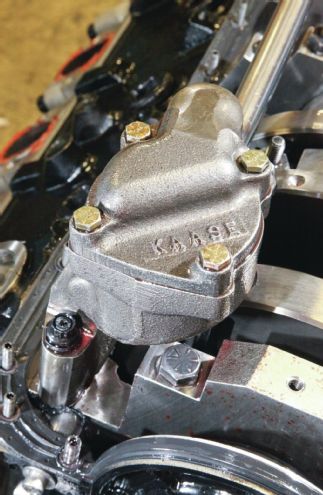 Oiling is provided by a Jon Kaase Racing oil pump. These iron versions are out of production now, but a new aluminum version is available.
Oiling is provided by a Jon Kaase Racing oil pump. These iron versions are out of production now, but a new aluminum version is available.
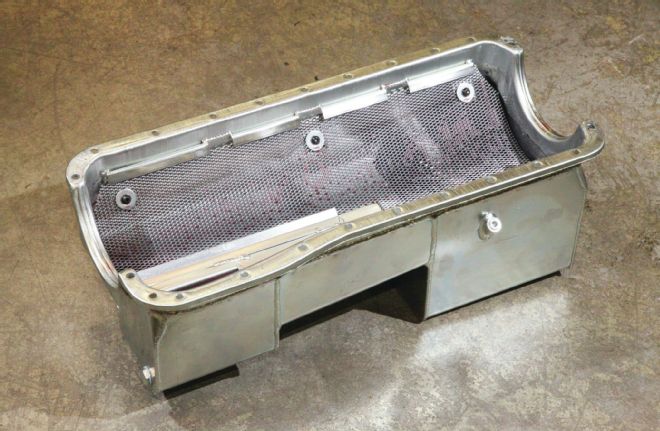 The Moroso oil pan is a standard Fox Mustang swap piece, since Freelander had planned to drop the engine into his car after the 2013 EMC competition. It hasn’t made it there yet, but we hear that may change after this year’s competition.
The Moroso oil pan is a standard Fox Mustang swap piece, since Freelander had planned to drop the engine into his car after the 2013 EMC competition. It hasn’t made it there yet, but we hear that may change after this year’s competition.
Freelander and Oakley may not have scored the highest via the EMC formula, but we have to verify that the Horsepower King and Torque Monster awards, both given to the contender with highest peak number, are handed out fairly. They don’t want to let go of the title either. Freelander says the big Ford will be back at EMC even bigger—632 ci. How much horsepower and torque will it make? You’ll have to tune into the competition to find out.
572ci Ford 385 Series RPM TQ HP 3,000 713 407 3,100 709 418.6 3,200 697 424.4 3,300 679 426.3 3,400 661 428 3,500 641 426.9 3,600 631 432.5 3,700 637 448.9 3,800 662 478.7 3,900 693 515 4,000 724 551 4,100 749 584 4,200 773 618 4,300 791 648 4,400 803 672 4,500 810 694 4,600 812 711 4,700 814 728 4,800 816 745 4,900 814 760 5,000 813 774 5,100 810 786 5,200 805 797 5,300 797 805 5,400 792 814 5,500 785 822 5,600 781 832 5,700 775 841 5,800 770 850 5,900 763 857 6,000 753 861 6,100 743 863 6,200 733 865 6,300 723 867 6,400 714 870 6,500 699 865 6,600 688 865 6,700 677 864 6,800 666 862 6,900 649 853 7,000 639 852
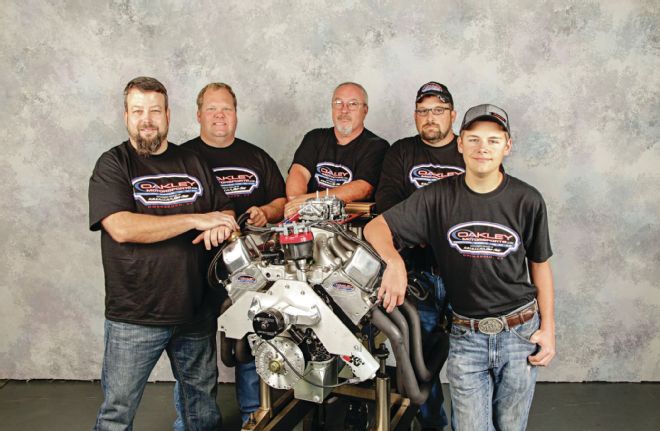 Meet the team that built this beast. From left to right: David Freelander, Phillip Oakley, Mike Miller, Jay Aokley, and Rob Orava.
Meet the team that built this beast. From left to right: David Freelander, Phillip Oakley, Mike Miller, Jay Aokley, and Rob Orava.